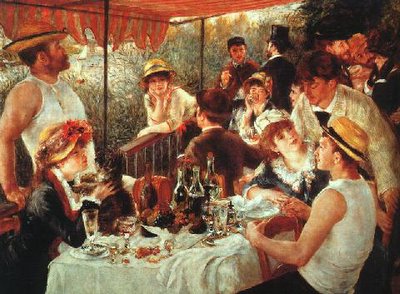Renoir

While most of the Impressionists were initially viewed by contemporary critics and buyers of art as gloomy revolutionaries, the sunnier personality of Pierre-August Renoir (born on this day in 1841 in Limoges, Haute-Vienne, France) and his Impressionist depictions of people at play did much to change their minds and hasten the acceptance of the style.
The son of a tailor, Renoir moved with his family to Paris when he was 4. The composer Charles Gounod was his choir-master at school, and considered Renoir to have some musical talent; but it was painting that he enjoyed, and he was apprenticed to a porcelain painter at the age of 13. Some writers suggest that his porcelain and fan painting had a formative effect on his style as a painter, particularly in his precise use of the brush, his handling of surfaces and texture and his delicate touch. It also provided him with his earliest artistic heroes, as much of his time in the fan painting trade was spent copying earlier masters such as Fragonard and Watteau.
He studied with Charles Gleyre in 1861, there beginning his friendship with Claude Monet, Alfred Sisley and Frederic Bazille, and later studied at the Ecole des Beaux-Arts. The first among his friends to achieve modest success in the art world (his Lise having met with uniform praise at the Salon in 1868), Renoir spent a year in the cavalry in 1871 and returned to find his paintings in demand among upper-middle class patrons.
He painted in the outdoors with Monet at his home at Argenteuil and shared in Monet's observations about color and its reflection. Renoir's paintings were very different from Monet's, however: for Renoir, people, not nature, were the focus, and in such paintings as La Loge (1874), Le Moulin de la Galette (1876) and The Luncheon of the Boating Party (1881), the pinkish-white skin of the elegant middle class at leisure seemed almost to be a source of illumination (albeit a reflecting source) in his paintings.
As he began to receive commissions from his wealthy patrons, Renoir slowly drifted away from Impressionism, a stance confirmed by his exposure to Raphael's work during a trip to Italy in 1881 and repeated visits with Paul Cezanne during the 1880s. From that point on, Renoir sought to reconcile the plein-air approach of the Impressionists with the sense of grandeur, dignity and simplicity of the classical painters. Despite criticism for his abandonment of the style which earned him success, he replaced free brushwork, spontaneous composition and a rainbow palette with linear refinement, gracefully contrived poses and drier coloration (such as in Grandes Baigneuses, 1884-87).
Partially due to an eye condition and arthritis, his painting during the first years of the 20th century had a broad, almost Expressionist feeling; and to relieve his eyes and hands, he took up sculpture. He died on December 2, 1919 at Cagnes-sur-Mer.
"Though he gave women a seductive appearance in his paintings, and conferred charms on those who had none, he generally took no pleasure in converse with them . . . he himself once said 'I paint women as I would paint carrots.'" -- G. Riviere.
Labels: Painting and Sculpture





0 Comments:
Post a Comment
Subscribe to Post Comments [Atom]
<< Home